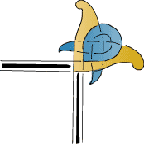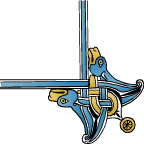ARTISTS AND CHIDDINGSTONE
Many artists have been inspired by Chiddingstone, and the village has also been used as a film set regularly. Chiddingstone has also been influenced greatly by artistic movements and changes in taste. The most obvoius examples of this are the changes to Chiddingstone Castle - starting with Henry Streatfeild taking the 'Grand Tour' on the continent and coming back filled with the inspiration to rebuild High Street House. Its later castellation was also driven by fashionable concerns. Here is a brief summary of notable artists linked with the village:
Charles Rennie Mackintosh
Mackingtosh visited Chiddingstone many times early in his career. He sketched many of the buildings in the High Street and his pictures of flowers from Chiddingstone are still on sale today.
Sir John Millais(1829-1896)
Millais was also a regular visitor to Chiddingstone.
A child prodigy in art, John Everett Millais entered the Royal Academy Schools at age 11, and exhibited at the RA from age 17. There he became friends first with Holman Hunt, and afterwards Rossetti, and these three founded the Pre-Raphaelite Brotherhood in 1848. Millais quickly moved from a mannerist to a realistic style in keeping with the Pre-Raphaelite ideal, and was coached by John Ruskin who took him to Scotland to paint in 1853. Millais produced the most well-known portrait of the famous critic in 1854, and incidentally married the wife of Ruskin after the latter's marriage was annulled. (She was the model for the soldier's wife in The Order of Release).
Millais's pictures include Cymon and Iphigenia, Lorenzo and Isabella, his first Pre-Raphaelite image, The Carpenter's Shop (much derided by Charles Dickens), Ferdinand lured by Ariel, Ophelia, with Elizabeth Siddall, later wife of Rossetti, in the title role, and subsequently The Vale of Rest and Autumn Leaves.
He thrived at the Royal Academy, becoming ARA as early as 1853, then RA and finally, in the year of his death, President of the Academy. However, his art became more popular, and he turned to pictures of society ladies, little girls, and fashionable lovers. His St Isumbras at the Ford, showing the knight and two oversweet children on an oversize horse, induced the young Frederick Sandys to draw a famous caricature featuring Millais as the knight, Rossetti and Holman Hunt as the children, and the donkey as John Ruskin.
Millais was also a notable illustrator during the 1860s, and worked much more consistently in this medium than most of the other Pre-Raphaelites. His important illustrations include six for Allingham's The Music Master, 18 for Moxon's Tennyson, two for Willmott's Poets of the 19th Century and 40 in Trollope's Orley Farm. Orley Farm in fact appeared originally in serial form in The Cornhill Magazine, and there are further Millais illustrations in this magazine, in Good Words, in Once a Week and in other periodicals.
Work by Millais can be seen at the Tate Gallery (Ophelia and The Vale of Rest), Birmingham (The Blind Girl), Manchester (Autumn Leaves), Liverpool (Lorenzo and Isabella at the Walker Art Gallery), Port Sunlight (St Isumbras at the Ford and The Black Brunswicker at the Lady Lever Gallery), and at the Ashmolean Museum, Oxford (Return of the Dove to the Ark). The Bride of Lammermoor is in Bristol. The Convalescent and Brighteyes are in the Aberdeen art gallery. Portraits by Millais can be seen at the National Portrait Gallery. A very early work, before Millais became a Pre-Raphaelite, is in Hove.
Arthur Rackham
Arthur Rackham stayed in Forge Cottage near Gilwyns and found inspiration for his dark faerie world in the landscape nearby.rthur Rackham was born September 19, 1867, in London, England. He studied at the Lambeth School of Art, was elected to membership in The Royal Watercolour Society and the Société Nationale des Beaux Arts, and became Master of the Art Workers' Guild. Books he illustrated included Rip van Winkle (1905), The Ingoldsby Legends (1906), Alice in Wonderland (1907), and many other children's books and classics throughout the years until his death in 1939. His last work, for The Wind in the Willows, was published posthumously. He won gold medals at Milan (1906) and Barcelona (1911), and his books and original art are now collected in many countries throughout the world.
"In imagination, draftsmanship and colour-blending, his work stands alone. His deep understanding of the spirit of myth, fable, and folklore affords him a transcendent range of expression." [Arthur Rackham, a Bibliography, by Sarah Briggs Latimore and Grace Clark Haskell, Los Angeles, Suttonhouse, 1936]
Rackham has been called "the leading decorative illustrator of the Edwardian period.... We see him.... in 1905 at the outset of twenty years of the most prolific and prosperous creative work ever enjoyed by an English illustrator." [Arthur Rackham, His Life and Work, by Derek Hudson, Charles Scribner's Sons, New York, 1960]
"Rackham's illustrations to Grimm, Hans Andersen or Poe show him at his most imaginative and observant of human nature, while his gnomes, fairies and gnarled anthropomorphic trees in Peter Pan in Kensington Gardens or A Midsummer Night's Dream represent his more fantastic side.... He was - and remains - a soloist in front of an orchestra, a player with the responsibility to interpret and add a personal lustre to great works with variations of infinite subtlety and grace." [Arthur Rackham: A Life with Illustration, by James Hamilton, Pavilion Books, Ltd., London, 1990; published in New York by Arcade Publishing, Inc. as Arthur Rackham, A Biography]
Walter Dendy Sadler(1854-1923)
Dendy Sadler was born in Dorking, and brought up in Horsham, where he showed a precocious talent for drawing. At age 16 he decided to become a painter and enrolled for two years at Heatherly's School of Art in London, subsequently studying in Germany under W. Simmler. He exhibited at the Dudley Gallery from 1872 and at the Royal Academy from the following year through to the 1890s. He painted contemporary people in domestic and daily life pursuits, showing them with comical expressions illustrating their greed, stupidity etc. Dendy Sadler was best known for his pictures of monks - his reputation was established with a picture of monks fishing called Steady Brother, Steady (1875), and his most well-known paintings are Thursday (in the Tate gallery and incidentally one of the first three pictures in Henry Tate's collection) also showing monks fishing, and Friday, where they are consuming their catch the next day. The monks are characterised as good natured but foolish looking fellows. The combination of realism with whimsicality follows an English tradition of almost slapstick humour, which seems to work better as black and white illustration in the pages of Punch or in light-hearted articles. Perhaps more to modern taste are Sadler's less blatant pictures, as in For Fifty Years (1894), showing an old gentleman happily offering his arm to his blank-faced bored wife - for him 50 years of domestic bliss, for her half a century of increasing dullness. In pictures like this, or An Offer of Marriage of 1895, Sadler also gives some of the best studies of Victorian interiors. He was criticised for this background detail, as it detracted from the subjects of his pictures, but it seems fair to me for a whimsical painting to provide encouragement for the eye to wander around the scene rather than being pushed too hard towards the 'point'.
Films and TV
Chiddingstone was used as a backdrop for 'A room with a view' and 'The Wind in the Willows' . The TV series 'Elizabeth R' was also shot here as well as a Victoria Wood Christmas Special.
|
|

